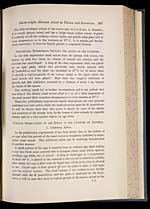Alexander Fleming (1881-1955)
On a remarkable bacteriolytic element found in tissues and secretions
Bacteriolytic Element found in Tissues and Secretions.
307
The fully developed colony of the coccus may be 2 or 3 mm. in diameter;
it is round, opaque, raised, and has a bright lemon yellow colour; it grows
luxuriantly on all the ordinary culture media, aud growth takes place well at
room temperature, or in the incubator at 37° C.; it is aerobic and faculta-
tively anaerobic; it does not liquefy gelatin or coagulated albumin.
PRELIMINARY EXPERIMENTS SHOWING THE ACTION OF THE LYSOZYME.
In the first experiment nasal mucus from the patient, with coryza, was
shaken up with five times its volume of normal salt solution, and the
mixture was centrifuged. A drop of the clear supernatant fluid was placed
on an agar plate, which had previously been thickly planted with
M. lysodeikticus, and the plate was incubated at 37° C. for 24 hours, when
it showed a copious growth of the coccus, except in the region where the
nasal mucus had been placed. Here there was complete inhibition of
growth, and this inhibition extended for a distance of about 1 cm. beyond
the limits of the mucus.
This striking result led to further investigations, and it was noticed that
one drop of the diluted nasal mucus added to 1 c.c. of a thick suspension of
the cocci caused their cornplete disappearance in a few minutes at 37° C.
These two preliminary experiments clearly demonstrate the very powerful
inhibitory and lytic action which the nasal mucus has upon the M. lysodeikticus.
It will be shown later that this power is shared by most of the tissues
and secretions of the human body, by the tissues of other animals, by vegetable
tissues, and, to a very marked degree, by egg white.
FURTHER OBSERVATIONS ON THE EFFECT OF THE LYSOZYME ON BACTERIA.
1. Inhibitory Action.
In the preliminary experiments it has been shown that on the surface of
an agar plate the growth of the nasal coccus is completely inhibited by super-
added nasal mucus. This inhibitory action can be strikingly demonstrated
in another manner.
A small portion of the agar is removed from an ordinary agar plate making
a cup into which some material rich in lysozyme (tears, nasal mucus, sputum,
cartilage, egg white, etc.) is placed. A drop of liquid agar, at a temperature
of about 50° C., is placed on the material in the cup and is allowed to solidify,
after which the cup is filled with the liquid agar which, in its turn, is allowed
to set. Liquid agar is then poured all over the plate to make a thin layer
over the original surface. The whole surface of the medium is now thickly
planted with the M. lysodeikticus and the plate is incubated for 24 hours,
when it will be seen that there is copious growth of the coccus, except in the
z 2


